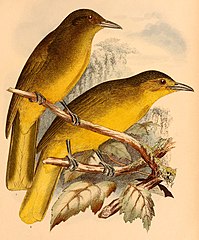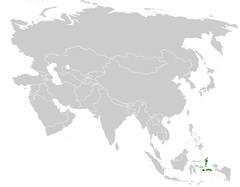Szczeciak złotawy
Szczeciak złotawy[3] (Hypsipetes affinis) – gatunek ptaka z rodziny bilbili (Pycnonotidae), występujący endemicznie w Indonezji (Azja Południowo-Wschodnia). Długość ciała 21–24 cm[4].
| Hypsipetes affinis[1] | |||
| (Hombron & Jacquinot, 1841) | |||
 Podgatunek longirostris | |||
| Systematyka | |||
| Domena | |||
|---|---|---|---|
| Królestwo | |||
| Typ | |||
| Podtyp | |||
| Gromada | |||
| Podgromada | |||
| Infragromada | |||
| Rząd | |||
| Podrząd | |||
| Rodzina | |||
| Rodzaj | |||
| Gatunek |
szczeciak złotawy | ||
| Synonimy | |||
| |||
| Podgatunki | |||
| |||
| Kategoria zagrożenia (CKGZ)[2] | |||
 | |||
| Zasięg występowania | |||

| |||
Taksonomia
edytujTakson po raz pierwszy opisany przez francuskich zoologów Jacques’a Hombrona i Honoré Jacquinota w 1841, którzy nadali nowemu gatunkowi nazwę Criniger affinis[5]. Jako miejsce typowe autorzy wskazali Waru na wyspie Seram należącej do Indonezji[5].
Systematyka gatunku jest kwestią sporną. W tradycyjnym ujęciu systematycznym wyróżnia się 9 podgatunków H. affinis[3][6][a], obecnie jednak część ujęć systematycznych (np. Międzynarodowy Komitet Ornitologiczny IOC i autorzy Handbook of the Birds of the World) zalicza doń tylko dwa podgatunki – affinis i flavicaudus, pozostałe albo wyodrębniając do dwóch osobnych gatunków H. longirostris i H. mysticalis, albo wszystkie z nich traktując jako odrębne gatunki[6][7][4][8][9]. Część systematyków zalicza szczeciaka złotawego i wydzielone z niego taksony do osobnego rodzaju Thapsinillas[6][7].
Zasięg występowania
edytujSzczeciak złotawy występuje w zależności od podgatunku[6]:
- H. affinis affinis – szczeciak złotawy – Seram
- H. affinis flavicaudus – Ambon
- H. affinis platenae – szczeciak żółtokantarowy – Wyspy Sangihe (na północny wschód od Celebesu)
- H. affinis aureus – szczeciak złoty – Wyspy Togian (na wschód od Celebesu)
- H. affinis harterti – szczeciak złotogardły – Banggai (na wschód od Celebesu)
- H. affinis longirostris – szczeciak wielkodzioby – Wyspy Sula (na wschód od Celebesu)
- H. affinis chloris – szczeciak zielonawy – Morotai, Halmahera i Bacan (północne Moluki)
- H. affinis lucasi – szczeciak żółtogardły – Wyspy Obi (północne Moluki)
- H. affinis mysticalis – szczeciak żółtolicy – Buru
Status
edytujMiędzynarodowa Unia Ochrony Przyrody (IUCN) dzieli ten takson na 8 odrębnych gatunków, 7 z nich zalicza do kategorii najmniejszej troski (LC, Least Concern)[2][10][11][12][13][14][15], a ósmy – szczeciaka żółtokantarowego (H. (a.) platenae) – uznaje za gatunek krytycznie zagrożony (CR, Critically Endangered)[16].
Uwagi
edytuj- ↑ Zobacz w infoboksie.
Przypisy
edytuj- ↑ a b Thapsinillas affinis, [w:] Integrated Taxonomic Information System [dostęp 2017-04-20] (ang.).
- ↑ a b Hypsipetes affinis, [w:] The IUCN Red List of Threatened Species (ang.).
- ↑ a b P. Mielczarek & M. Kuziemko: Rodzina: Pycnonotidae Gray,GR, 1840 - bilbile - Bulbuls (wersja: 2021-01-16). [w:] Kompletna lista ptaków świata [on-line]. Instytut Nauk o Środowisku Uniwersytetu Jagiellońskiego. [dostęp 2021-09-23].
- ↑ a b L. Fishpool, J. Tobias: Family Pycnonotidae (Bulbuls). W: J. del Hoyo, A. Elliott, D.A. Christie: Handbook of the Birds of the World. Cz. 10: Cuckoo-shrikes to Thrushes. Barcelona: Lynx Edicions, 2005, s. 236–237. ISBN 84-87334-72-5. (ang.).
- ↑ a b J.B. Hombron, H. Jacquinot. Description de plusieurs Oiseaux nouveaux ou peu connus provenant de l'expédition autour du monde faite sur les corvettes l'Astrolabe et la Zélée. „Annales des sciences naturelles, Zoologie”. Seconde Série. 16, s. 313, 1841. (fr.).
- ↑ a b c d F. Gill, D. Donsker & P. Rasmussen (red.): IOC World Bird List (v11.2). [dostęp 2021-09-23]. (ang.).
- ↑ a b Fishpool, L., Tobias, J. & Kirwan, G.M.: Seram Golden Bulbul (Thapsinillas affinis). [w:] del Hoyo, J., Elliott, A., Sargatal, J., Christie, D.A. & de Juana, E. (red.). Handbook of the Birds of the World Alive [on-line]. 2019. [dostęp 2019-11-03].
- ↑ F.E. Rheindt, R.O. Hutchinson. A photospot odyssey through the confused avian taxonomy of Seram and Buru (southern Moluccas). „Birding Asia”. 7, s. 18–38, 2007. (ang.).
- ↑ Handbook of the Birds of the World and BirdLife International, Handbook of the Birds of the World and BirdLife International digital checklist of the birds of the world. Version 5 [online], grudzień 2020, s. 445 [dostęp 2021-09-23].
- ↑ Hypsipetes aureus, [w:] The IUCN Red List of Threatened Species [dostęp 2021-09-23] (ang.).
- ↑ Hypsipetes harterti, [w:] The IUCN Red List of Threatened Species [dostęp 2021-09-23] (ang.).
- ↑ Hypsipetes longirostris, [w:] The IUCN Red List of Threatened Species [dostęp 2021-09-23] (ang.).
- ↑ Hypsipetes chloris, [w:] The IUCN Red List of Threatened Species [dostęp 2021-09-23] (ang.).
- ↑ Hypsipetes lucasi, [w:] The IUCN Red List of Threatened Species [dostęp 2021-09-23] (ang.).
- ↑ Hypsipetes mysticalis, [w:] The IUCN Red List of Threatened Species [dostęp 2021-09-23] (ang.).
- ↑ Hypsipetes platenae, [w:] The IUCN Red List of Threatened Species [dostęp 2021-09-23] (ang.).
Linki zewnętrzne
edytuj- Zdjęcia i nagrania głosów – szczeciak złotawy (affinis + flavicaudus). [w:] eBird [on-line]. Cornell Lab of Ornithology. (ang.).
- Zdjęcia i nagrania głosów – szczeciak złoty (aureus). [w:] eBird [on-line]. Cornell Lab of Ornithology. (ang.).
- Zdjęcia, nagrania głosów i krótkie filmy – szczeciak wielkodzioby (harterti + longirostris). [w:] eBird [on-line]. Cornell Lab of Ornithology. (ang.).
- Zdjęcia, nagrania głosów i krótkie filmy – szczeciak zielonawy (chloris). [w:] eBird [on-line]. Cornell Lab of Ornithology. (ang.).
- Zdjęcia, nagrania głosów i krótki film – szczeciak żółtogardły (lucasi). [w:] eBird [on-line]. Cornell Lab of Ornithology. (ang.).
- Zdjęcia, nagranie głosu i krótki film – szczeciak żółtolicy (mysticalis). [w:] eBird [on-line]. Cornell Lab of Ornithology. (ang.).